Customer-Centric Marketing: The Key to Enhancing Your Brand
The modern marketing landscape is dynamic, complex, and extremely fast-paced. To stay ahead of the curve and remain competitive, brands need to update their strategies and tactics consistently.
To remain relevant in today’s increasingly digital world, marketers need to focus on becoming more customer-centric. This requires rethinking current processes and identifying new ways to create experiences that are more tailored to individual needs. Read on to learn more about why your brand should adopt a more customer-centric approach to your marketing strategy along with some helpful tips for doing so.
What is Customer-Centric Marketing?
Customer-centric marketing is an approach to marketing where the focus is on the customer and their needs and experience. In other words, it is an approach that puts the customer first and their needs and desires at the center of all marketing activities. Both the product and the marketing strategy are designed to fulfill the customer’s wants and needs.
This may be in the form of an improved customer experience, a tailored marketing message, or a new product or service that solves a specific pain point or need. Customer centricity is a mindset that requires marketers to think about their audience on a more individualized level and tailor their marketing efforts accordingly.

Source:Gartner
This means considering things like a customer’s interests, behaviors, demographics, and location. It also helps marketers to better understand how customers interact with their brand daily by using tools and data tracking software to get a better grasp of those interactions.
Why is Becoming More Customer-centric so Important?
A customer-centric approach ensures that your marketing efforts are relevant to your audience. It provides customers with more meaningful and personalized experiences.
Becoming more customer-centric is necessary for brands that want to stand out and ensure that their offerings are relevant and valuable to their customers. As customer preferences and needs change over time, brands that remain static have a much harder time standing out from the pack.
A customer-centric approach allows brands to stay ahead of their competition and evolve along with their customers’ ever-evolving needs and desires.
How to Be More Customer-centric in Your Marketing Strategy

To improve your brand’s customer centricity, there are a few things that you’ll need to consider.
First, you’ll want to make sure that you have a firm grasp on who your audience is and where they’re located. There are a variety of tools and resources that can help you to better understand your audience, such as the following:
- Customer personas
A customer persona is a fictitious representation of one of your customers. It includes information such as the customer’s age, gender, geographic location, and psychographics, such as their interests, desires, and motivations. Personas can help you stay focused on your customer base when you’re creating new marketing strategies.
- Behavioural data
Behavioral data refers to the way that customers interact with your product and your marketing. Analyzing this data can help you identify pain points and discover areas for improvement. It can also help marketers discover which marketing strategies are resonating most with customers.
- Change Your Marketer Culture
One of the first things that you’ll want to do is change the way that marketers interact with customers. Most marketers are used to sitting at their desks, waiting for customers to come to them. The customer-centricity approach requires marketers to seek out their customers and actively engage with them instead.
This can be done through various means, such as social media, email marketing, and content marketing. It can also include things like attending events and speaking at conferences, as well as creating customer interviews and surveys, and actively seeking out customer feedback.
Marketers that actively engage with customers consistently will have a better understanding of what their customers are looking for and what they need from the brand. This knowledge can then be applied to the creation of new marketing strategies and the improvement of existing ones.
- Implement Effective Tracking Processes
Another important aspect of being more customer-centric is implementing tracking processes that allow you to better understand how your customers are engaging with your brand daily and where they are having issues.
If customers are having issues completing a certain action or navigating through your website, you can use tracking processes to identify and fix those problems. You can also use tracking processes to understand how long a certain action is taking and how frequently customers are engaging with different aspects of your brand.
This can be especially helpful if you have a wide variety of customers who are using your brand in unique ways. For example, if you have a clothing brand, you can use tracking processes to understand how long it is taking women versus men to shop for a particular item, or how long certain items are taking certain customers to find.
This can help you to identify areas for improvement and make sure that your customers can complete the actions that they need to do as quickly and easily as possible.
- Create Engagement Strategies for Marketing Channels

Marketing channels are the platforms and avenues that you use to reach your customers. Some of the most popular marketing channels include email marketing, social media, eCommerce, and video marketing. It is important to engage customers across all of these channels, but it’s also important to understand which ones are best for your audience.
This is when you’ll want to look back at the information that you’ve collected on your audience and use it to decide which marketing channels are best suited for your customers. You can do this by using a customer engagement strategy to guide your decisions.
For example, you may decide that your customers are most engaged with your content when they are using social media, while they are mostly reading your emails when they are on their phones. This knowledge can help you to better focus your marketing efforts and make sure that you are engaging with customers across all channels.
- Utilize Automation and Machine Learning
Another aspect of being more customer-centric is implementing automation and machine learning into your marketing efforts. Automation is the process of completing routine tasks without the need to manually do them. In the context of marketing, automation can be used to create consistent and relevant content, send emails at scheduled times, and track customer behavior and actions.
Machine learning is the process of training computer algorithms to complete complex tasks by feeding them data and tracking their outcomes. In marketing, machine learning can be used to analyze customer data and create personalized and relevant experiences for each customer. For example, marketing teams can link data with Claude and other AI agents to generate actionable insights and even predict customer behavior across channels.
Automation can help to make your marketing efforts more efficient, while machine learning can help you to provide customers with more personalized experiences. Both of these tools can help marketers stay focused on high-priority items while also assisting customers with basic needs and questions.
- Leverage Other Platforms and Tools in your Marketing Toolkit

These days, almost every aspect of marketing is done online. It is important to leverage the tools and platforms that are available to you to become more customer-centric. In today’s digital landscape, there are countless tools and resources available to marketers.
You can use these tools to improve your brand’s customer-centricity by providing more personalized experiences. You can use tools and data from Google Analytics, Facebook, and YouTube to better understand your customers' behaviors and preferences.
You can also use them to create more personalized experiences for your customers. For example, you can use data to understand what time of day certain customers usually visit your website and create content that is geared towards those individuals.
Summing up
The modern marketing landscape is constantly evolving, and brands that are slow to adapt will quickly become irrelevant. To stay competitive, brands need to constantly be evolving and improving their strategies and tactics.
The best way to do so is by becoming more customer-centric and leveraging data to create more personalized experiences. By doing so, marketers can better understand their customers and create experiences that are more meaningful and tailored to individual needs.










![Top 10 Route Alternatives & Competitors [2026]](https://blog.parcelpanel.com/wp-content/uploads/2025/11/Route-Altenatives.png)

![Top 10 parcelLab Alternatives & Competitors [2026]](https://blog.parcelpanel.com/wp-content/uploads/2025/11/AfterShip-Altenatives-9.png)













